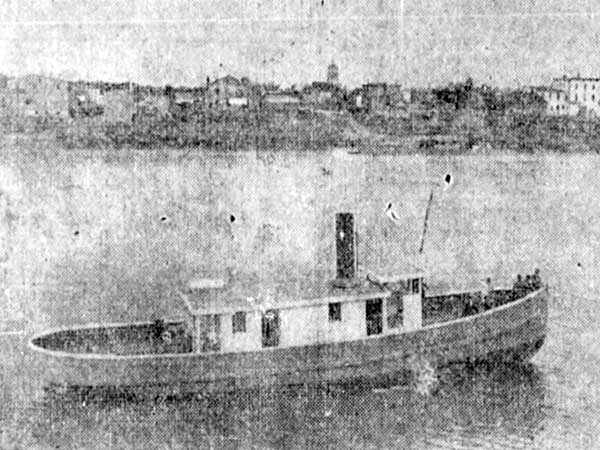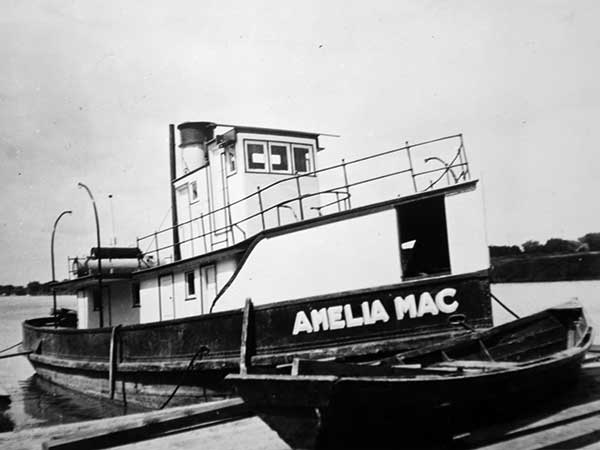Originally designed and laid down in 1909 at a cost of about $15,000, the Amelia Mac was built by the Doty Engine Works (later The Sterling Engine Works Limited) over the course of the entire summer in a shipyard at the foot of Water Avenue in Winnipeg. Commissioned and financed by Charles Hosmer McNaughton for the Arctic Ice Company, the Amelia Mac was the first all-steel vessel launched on the Red River. On 1 August 1910, at a launch ceremony attended by many prominent Winnipeggers, the twin-deck and twin-screw tug was christened with champagne and named for McNaughton’s daughter Amelia Barbara McNaughton (1888-1931). The tug featured a folding smokestack to allow for ease of passage beneath bridges, and was 16 feet in beam, drawing 7 feet when loaded. Its speed was 11 miles per hour and when fully staffed, it had a crew of four: captain, cook, deck hand, and engineer. On account of its steel hull, the Amelia Mac was able to break through ice jams when required.
At least once a day, the 66-foot-long vessel was used for towing large covered barges of ice from the docks at St. Norbert, and ice storage sites elsewhere, to distribution depots at Bell Avenue or the Alexander Docks at Pritchard Avenue. It also saw select service as a personnel transport, such as for the Elmwood Boy Scouts to their annual camp at St. Norbert (1913) and other occasions, though its capacity was not suitable for large groups.
The Amelia Mac remained in active service with the Arctic Ice Company through 1932, traveling an estimated 169,000 miles, and boasted an excellent safety record. Its practicality and service diminished as electric refrigeration became more common and, after 1932, her formal business usage was discontinued. The ship itself remained in service for occasional uses, while one of the company’s three large ice barges was sold to become a dance hall at Hyland Park.
In 1932, the ship and Captain H. Luke Whalen took part in grand, formal celebrations marking Winnipeg’s 50 years of development in the West. It hosted such dignitaries as Charles Napier Bell, the original customs officer to sign for the first wheat consignment, Alex Gibson of Springfield, the sole survivor of the 12 farmers who supplied the wheat, and Richard Spear and James Spear, owners of the original covered wagon used to transported the wheat to the boat. The ceremony included signing a replica bill-of- trade to the one used aboard the SS Selkirk in 1876, when the first wheat shipment was conducted. It then transported select dignitaries upstream to the Manitoba Agricultural College where the program continued.
The Amelia Mac was laid up from 1933 to 1938 prior to being sold to the Brown & Rutherford Company Limited in March 1938, and refitted for work transporting personnel and freight from the city to sawmill operations along the shores of northern Lake Winnipeg, as well as moving lumber barges from Birch Point in Fisher Bay to the Pine Falls Paper Mill. In 1942, it was three-quarters sunk at the Brown and Rutherford docks near the Louise Bridge after young vandals opened its watercocks. It was raised and returned to service a month later after the water levels dropped sufficiently. Following the 1950 Winnipeg flood, the boat was completely gutted except for its hull and stern engine array. In October 1955, it was purchased by the Winnipeg Selkirk Sand Company (renamed the Selkirk Silica Sand Company in 1958) and fully refitted, complete with new twin 150-horsepower diesel engines. It was used to dredge silica sand for the production of industrial glass and saw service for the company in the waters around Black Island in Lake Winnipeg.
Around 1960, the vessel was leased to the Drake Construction Limited and Pearson Construction Limited, and used by the Selkirk Navigation Company to haul oil and diesel to the Grand Rapids Hydro project. In December 1965, the Winnipeg Supply and Fuel Company acquired the Selkirk Silica Sand Company. The ship was used to transport barge-loads of gravel and silica for riverbank stabilization projects throughout Winnipeg. The passage went from the southern end of Lake Winnipeg at Balsam Bay along a 65-mile route up the river into the City of Winnipeg docks, where it was then trucked to the company’s plant at St. James. At the time, the operation was the largest maritime operation in Winnipeg history. In April 1972, the Steel Brothers Canada Limited acquired the Winnipeg Supply and Fuel Company and its assets, including the Amelia Mac. The vessel was hauled out of the water at Riverton some time before 1986 and sold to a company which has since gone bankrupt. In 2004, the Vessel Registry entry for the ship was closed.

Amelia Mac (1910)
Source: Winnipeg Tribune, 2 August 1910, page 1.

Amelia Mac (circa 1938)
Source: Archives of Manitoba, Transportation - Boat - Amelia Mac #1.
Period
Owner
1910-1938
1938-1955
1955-1965
Selkirk Silica Sand Company
1965-1972
Winnipeg Supply & Fuel Company
1972-2004
Steel Brothers Canada Limited, later a division of Brock White Canada
“First steel boat launched in Winnipeg,” Winnipeg Tribune, 2 August 1910, page 1.
“Rush of ice in river plays havoc with big boats,” Manitoba Free Press, 12 April 1913, page 8.
“Ice breaking up,” Manitoba Free Press, 7 April 1913, page 24.
“Elmwood Boy Scouts,” Manitoba Free Press, 24 July 1913, page 7.
“Making artificial ice an intricate process,” Winnipeg Evening Tribune, 12 April 1924, page 4.
“Manitoba’s first wheat shipment 56 years ago will be commemorated,” Winnipeg Free Press, 11 June 1932, page 4.
“Ceremony at unveiling of monolith recalls pioneer days in West,” Winnipeg Free Press, 16 June 1932, page 1.
“Unveiling ceremony recalls 50 years of development in West,” Winnipeg Free Press, 16 June 1932, page 7.
“Veteran of early days in Winnipeg succumbs Friday,” Winnipeg Free Press, 28 May 1932, page 5.
“Pioneer of Red River fleet goes to take open lake when ice goes,” Winnipeg Evening Tribune, 7 March 1938, page 5.
“Open waters,” Winnipeg Free Press, 7 March 1938, page 5.
“Amelia takes a dip,” Winnipeg Tribune, 22 October 1942, page 1.
“Sinks in waters of Red,” Winnipeg Free Press, 22 October 1942, page 9.
“Celebrating 80 years experience in Winnipeg,” Winnipeg Free Press, 1 November 1952, page 9.
[Photo caption, Amelia Mac], Winnipeg Free Press, 5 October 1955, page 9.
“New fleet of tugs, barges to haul freight to Hydro project,” Winnipeg Free Press, 11 June 1960, page 14.
“Barges, not trucks,” Winnipeg Free Press, 26 May 1962, page 3.
“First steel vessel on the lake,” Winnipeg Free Press, 24 August 1963, page 20.
“Mineral production hits new high,” Winnipeg Free Press, 29 April 1969, page 31.
“Steamboat story an exciting chapter in province’s history,” Winnipeg Free Press, Weekly Rural Edition, 14 April 1991, page 10.
Amelia Mac - Articles of agreement and ship’s log, RG 12 1987-88/133 93, Library and Archives Canada.
Transport Canada, Vessel Registration Query System
Nauticapedia.ca, Amelia Mac
Steels.com, Steels Corporate Timeline
This page was prepared by Nathan Kramer.
Page revised: 12 February 2022